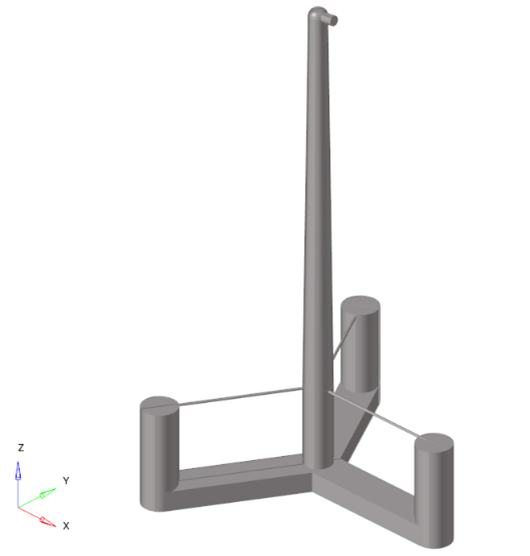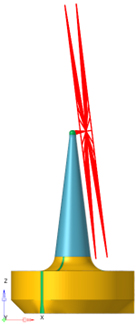Simulating Sustainable Wind Generation with Texas Wind Tower
The demand for renewable energy has increased in recent years, as has the desire to transition from traditional to sustainable energy sources. Offshore wind tower structures are one of the emerging technologies that have the potential to transform the way people harness and utilize wind energy. The electricity these turbines produce travels back to land via a series of undersea cable systems and can power coastlines around the world on a massive scale.
Conventionally, the structures that house these turbines have been fixed to the seabed. This confines wind farms to offshore areas at a certain depth. To expand these turbines’ viability, a recent focus has been developing floating wind structures. These floating structures will increase wind energy’s potential output since they can be deployed in much deeper areas of the ocean. This opens up a much greater percentage of the ocean to wind electricity development that is clear of surrounding barriers.
Texas Wind Tower, a startup pioneering the development of floating wind tower technology, collaborated with Altair to develop an advanced workflow for the design, validation, and optimization of floating wind tower structures via optimization technology and naval architecture software. To perform topology optimization during the concept development stage, Texas Wind Tower used Altair OptiStruct alongside with MAESTRO by MAESTRO Marine, which is available through the Altair Partner Alliance (APA).
Floating Platform Design Process Development
To begin the design development, Texas Wind Tower selected UHPC, a high-performance cementitious composite (concrete) due to its ability to deliver on a handful of critical characteristics for an improved offshore floater. UHPC is great at delivering optimized, naturalistic forms that are more structurally efficient than other build materials and methods. With UHPC, the teams could reduce costs and the time it takes to develop the offshore floater while lengthening its service life. Additionally, localized (on-site) construction was more achievable, the concrete’s cost stability lowers cost overrun risk, and greenhouse gas emissions could be lowered when using UHPC. Materials like carbon-neutral concrete are becoming more popular because of their significant sustainability virtues.

The first platform mock-up created by Altair, based off of the University of Maine platform design.

The initial platform design and dimensions that Altair used as a reference point (Image source: Definition of the UMaine VolturnUS-S Reference Platform Developed for the IEA Wind 15- Megawatt Offshore Reference Wind Turbine).
Together, Altair and Texas Wind Tower developed the floating wind structure’s design targets, including height and footprint dimensions, mass, center of gravity, waterline, ballast volume, and stability. The team used these targets to develop the initial wind simulation. Details, design targets, and dimensions were also derived from a technical report.
Using MAESTRO for hydrostatic loading and static wind loading data sourced from a technical report on the design of concrete offshore platforms, loading conditions along with boundary conditions were established from the teams’ research.
Model Setup and Design Iterations


The design space used for the topology optimization set-up.
Once conditions were created, the team applied loading and boundary condition cases to the design volume and used optimization tools and techniques to generate an initial material layout of the load paths using OptiStruct. A topology optimization approach helped the team find the primary load paths to support the different load cases, while maximizing stiffness and meeting design constraints.
Running through different optimization setups with these tools, the team generated concept designs for evaluation. After multiple design iterations, the team designed the structure to be more buoyant, more manufacturable, and they added additional columns to improve stability on the water.

Model #3 optimization results.
The team refined the concept based on performance and feasibility. Hydrostatic and stabilization analyses showed local high stress areas, revealing where the team needed to add additional material to meet design targets and performance goals. With each design iteration, Altair learned how to make the necessary improvements to reach an optimal result.

The different design stages that occurred throughout the design process.
Results
Thanks to Altair and APA technology, Texas Wind Tower could create a fully developed, advanced workflow for floating wind turbines. Altair, Texas Wind Tower, and MAESTRO continue to develop these methods and are on their way to creating a streamlined and semi-automated process for optimizing, designing, and analyzing these massive floating structures.

The latest iteration of the offshore wind tower floater concept.
The creation of energy in all forms – whether it be a set of wind towers or a large-scale solar farm – is increasingly renewable in nature. As demand grows, the industry is working toward replacing and upgrading existing infrastructure with more sustainable designs.
Altair's simulation and optimization technologies support the increasing development of renewable energy technology. Fast solver speed and efficiency allows users to study and model the energy industry’s most advanced multiphysics problems. Altair’s technology in this area covers some of the renewable energy industry’s most vital needs, including turbine vortex simulation and prediction, acoustic interpretation and assessment, wind farm siting, composite blade analysis and optimization, and transmission dynamics simulation and optimization.
For more information on Altair’s solutions for energy and architecture, engineering, and construction (AEC), visit https://www.altair.com/energy and https://www.altair.com/architecture-engineering-construction.




